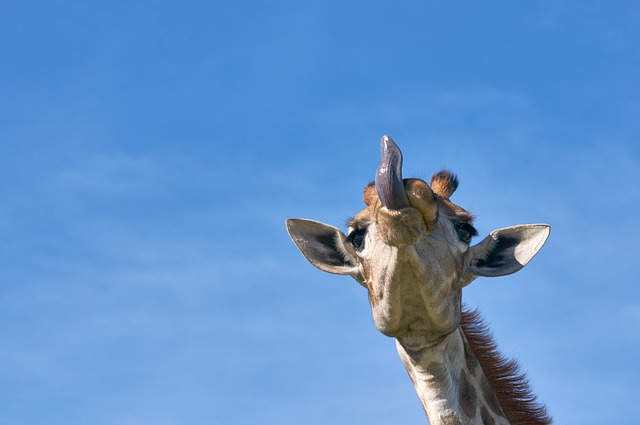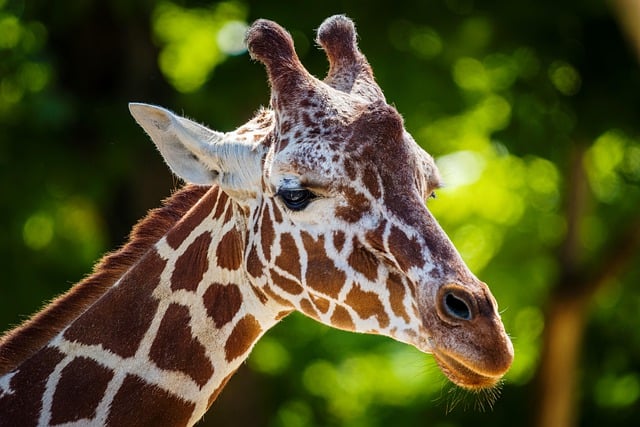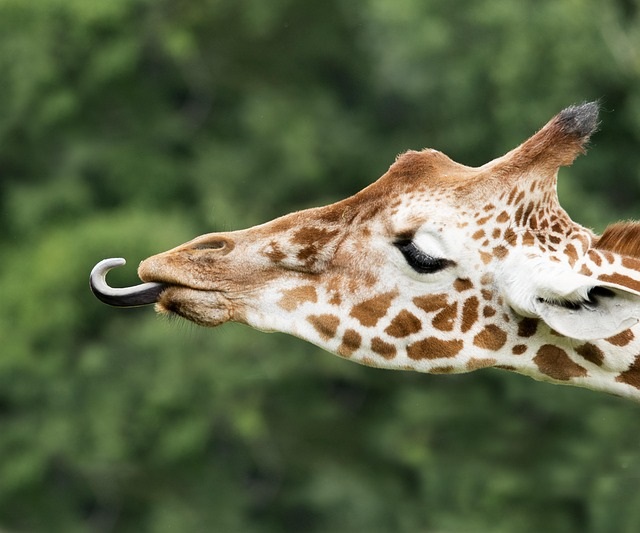When you think of giraffes, their long necks might be the first thing that comes to mind. But one of their most fascinating and essential adaptations is their giraffe tongue. More than just a feeding tool, the giraffe’s tongue is a remarkable evolutionary feature that helps them survive in the African savanna. From its unusual color to its impressive functionality, let’s explore what makes the giraffe’s tongue so special.
Why Do Giraffe Tongues Have Different Colors?
The Role of Melanin in Giraffe Tongue Color
Giraffe tongues are typically dark blue, purple, or black, helping them withstand prolonged exposure to the sun while feeding. This is due to the high concentration of melanin, which acts as a natural sunscreen, preventing sunburn while they graze for hours each day.
How Age Affects Tongue Color
The color of a giraffe’s tongue can vary slightly between individuals and changes with age. Young giraffes tend to have lighter-colored tongues, which darken as they grow older due to increased melanin production.
Why Giraffe Tongues Look Different in Sunlight vs. Shade
Lighting conditions can also make a giraffe’s tongue appear different colors. In direct sunlight, the purple hue may look vibrant, while in shade, it can appear much darker.
How Long is a Giraffe’s Tongue?
Giraffe tongues measure between 18-20 inches (45-50 cm), making them one of the longest tongues in the animal kingdom relative to body size. Their prehensile tongues act like an extra limb, allowing them to grab and strip leaves from branches with precision.
Comparison of Giraffe Tongue Length with Other Animals
| Animal | Tongue Length | Primary Function |
| Giraffe | 18–20 inches (45–50 cm) | Feeding, grooming, hydration |
| Okapi (Giraffe’s close relative) | 14–18 inches | Stripping leaves, self-cleaning |
| Blue Whale | Up to 18 feet | Filtering food from water |
| Chameleon | 1.5 times body length | Catching prey |
| Human | 3–4 inches | Speaking, tasting, swallowing |
How Giraffes Use Their Tongues for Survival
Adapting to Thorny Trees: Acacia Feeding Strategies
Giraffes primarily feed on acacia trees, which are covered in sharp thorns. Their prehensile tongues, along with thick saliva and papillae (tiny finger-like projections), protect them from injuries while foraging.
Using the Tongue for Grooming and Cleaning
Giraffes also use their tongues to clean their nostrils, eyes, and even ears, helping to remove dirt and parasites.
How Giraffe Tongues Help in Hydration During Droughts
Giraffes extract moisture from leaves, allowing them to go long periods without drinking water. This adaptation is especially useful during droughts.
The Science Behind Giraffe Tongue Functionality
Prehensile Tongues – The Secret to Efficient Feeding
Giraffe tongues function similarly to an elephant’s trunk, allowing them to grasp and manipulate objects while feeding.
Thick Saliva: A Natural Defense Against Thorns
Their thick, antimicrobial saliva helps prevent infections from thorn-related injuries.
How Giraffe Tongues Inspired Soft Robotics
The flexibility and strength of giraffe tongues have influenced biomimicry research, particularly in the development of soft robotic grippers used in medical and industrial applications.
Why Captive Giraffes Use Their Tongues Differently
Differences in Feeding Habits in Zoos vs. the Wild
In captivity, giraffes are often fed prepared hay and vegetables, meaning they don’t need to use their tongues as extensively as wild giraffes.
How Zoos Encourage Natural Foraging Behavior
To keep their tongues active, zoos provide puzzle feeders and enrichment devices, mimicking natural foraging behaviors.
Fun Facts About Giraffe Tongues
- Giraffes can lick their own ears!
- Their tongues are strong enough to snap small branches.
- Baby giraffes are born with fully functional tongues and start feeding almost immediately.
Debunking Common Myths About Giraffe Tongues
Myth: Giraffe Tongues Are Blue Because of Their Diet
Fact: Their tongues are dark due to melanin, not food.
Myth: Giraffe Tongues Are Slimy
Fact: They are dry and tough, built to handle thorny branches.
Myth: Giraffes Only Use Their Tongues for Eating
Fact: They also use them for grooming, hydration, and social interactions.
Frequently Asked Questions About Giraffe Tongues
Q1: What color is a giraffe’s tongue and why?
A giraffe’s tongue is typically blue, black, or purple due to high levels of melanin, which protects it from the sun.
Q2: Why do some giraffes have darker tongues than others?
Giraffe tongues darken with age as melanin production increases. Genetics and sun exposure also influence color variations.
Q3: Can a giraffe’s tongue change color over time?
Yes! Baby giraffes often have lighter tongues that darken as they grow older.
Q4: Do all giraffes have the same tongue color?
Not exactly. While most giraffes have a dark purple, blue, or black tongue, slight variations exist due to genetics and lighting conditions.
Q5: How does a giraffe’s tongue help it survive?
A giraffe’s tongue helps them:
- Reach high branches
- Avoid thorn injuries
- Protect against the sun
- Extract moisture from leaves
- Groom themselves
Q6: How is a giraffe’s tongue different from other animals?
Giraffe tongues are:
- Much longer (18-20 inches)
- Dark-colored (for sun protection)
- Prehensile (for gripping food like an extra limb)
- Thick and rough (for protection against thorns)
Q7: Do giraffes clean themselves with their tongues?
Yes! Giraffes use their tongues to clean their nostrils, eyes, and even ears.
Q8: How do giraffes eat thorny acacia trees without getting hurt?
Their tongues have tough, thick papillae and thick saliva that protect against thorn injuries.
Q9: Do giraffes need to drink water, or do they get enough from leaves?
Giraffes get up to 70% of their water from leaves, reducing their need to drink.
Q10: What’s the longest tongue in the animal kingdom?
While giraffes have the longest tongue relative to body size, the blue whale has the largest tongue overall, measuring up to 18 feet long!
Conclusion
The giraffe’s tongue is an evolutionary marvel. Its dark pigmentation protects against sun damage, its prehensile nature allows precise feeding, and its thick texture prevents injuries. Whether in the wild or captivity, a giraffe’s tongue remains one of nature’s most fascinating adaptations.






